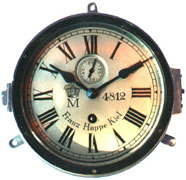|
|
Producer/Hersteller:
Franz Happe Kiel,
Werk: Gustav Becker, Freiburg Schlesien, |
|
|
Producer/Hersteller:
Franz Happe Kiel,
Werk: Gustav Becker, Freiburg Schlesien, |
 |
 |
 |
 |
| Beschreibung:
Schiffs-Wanduhr Franz Happe Kiel Registrierung: Kaiserkrone M 4173 Werk: Gustav Becker Freiburg Silesia Schiffsuhr der Kaiserlichen Marine während des 1. Weltkrieges für das U-Boot C 76, Gehäuse Messing 15cm D, Zifferblatt signiert 'Franz Happe Kiel' mit der Kaiserkrone, der Marine Nr. M 4173, römische Indikation kleine Sekunde, Gangverstellung (V/N), die Uhr war auf ein starkes Buchenholzbrett montiert. Franz Happe war Chronometermacher in Kiel und nutzte zunächst englische Rohwerke, später solche aus Glashütte. Diese Schiffsuhren wurden von mehreren Uhrmacher montiert, so von A. Schuchmann Wilhelmshaven, Fritz Titz Kiel und Johannes Czapp, Danzig, Kohlengasse 5. Dies waren auch die deutschen Häfen mit den Kaiserlichen Marinewerften im 1. Weltkrieg mit Zugang zur Nordsee, dem scandinavischen Belt und der offenen Ostsee. Die Herkunft der rel. massiven Gehäuse ist unbekannt, sie wurden auch bei der Kriegsmarine zu Beginn des 2. Weltkrieges genutzt, dann jedoch mit Werken von Kieninger & Obergfell mit Zentralsekunde. Gustav Becker war ein weltberühmter Hersteller von Grossuhren
und Werken in Freiburg Schlesien. Verwendung:
Das Boot U /6 wurde am 25.11.1916 fertig und am 17.12. an die Marine übergeben. Am 10. Mai 1917 sank durch eine Expolsion einer eigenen Mine in der Nähe von Helgoland. Es wurde dann durch das Bergungsschiff 'Oberelbe' gehoben und nach dem Waffenstillstand 1918 nach Karlskrona in Schweden gebracht. Am 1.12.1918 ging es als Kriegsbeute nach England und wurde 1919-20 in der Briton Ferry Werft in Swansea abgewrackt. |
Description:
Ships Clock Franz Happe Kiel Registratrion: Crown M 4173 Movement: Gustav Becker Freyberg Silesia Kaisermarine clock for U-Boat 76, constructed in oxidised brass, the metal painted 6in. (15 cm) dial signed Franz Happe Kiel and numbered 4173, with the Kaisermarine 'M' beneath an Empire Crown, Roman numerals, seperate seconds subsidiary dial, fast/slow (V/N) lever, single winding hole to going barrel movement, the whole mounted on a wooden 'shield' with plaque for UC76 at top, metal plate for wall hanging - 13 ½ in. (34cm.) high. Franz Happe was a chronometer maker in Kiel. For chronometers he used parts from British makers and later from Glashütte. He as well mounted clocks with cases used by other contemporary clockmakers like 'A. Schuchmann Wilhelmshafen, Fritz Titz Kiel, and Johannes Czapp Danzig. These were as well the locations of the 'Kaiserliche Werft' (Imperial Warfts) and these were the main ports of the German Navy in WWI. for the North Sea, the Scandinavian Belt and the Baltic Sea. The same brass cases were used later for Kriegsmarine clocks with movement from Kieninger with zentral second. Gustav Becker was a very famous movement- and clock-maker in Freyberg Silesia. Application: UC-type German Submarines Like all UC-type submarines introduced into tue German Navy after the spring of 1915, UC76 was intended as a coastal minelayer. With over one hundred similar boats eventually completed, it was inevitable that the basic design would be modified with experience and UC76 was one of the last batch of the second type (UCII - Nos. UC16-79) which were double-hulled and had a larger range with better sea-going qualities than the UCI's. Displacing 410 tons (surfaced) and 493 tons (submerged), the final group of UCI's (Nos. 74-79) were 165 ½ feet long and built in the Vulcan Yards at Stettin. Fitted with six mine tubes and three torpedo tubes, they also carried a 3.45 in. deck gun and could run at 11.8 knots (surfaced) and 7.3 knots (submerged). UC-76 Submarine was launched on 25 November 1916 and commissioned that 17 December. On 10 May 1917, she was sunk near Helgoland when one of her own mines exploded in the lunching tube and 15 of her 26 crew were killed. Subsequently raised by the salvage vessel 'Oberelbe', she was thereafter used for training until the Armistice when she made a runi for the Swedish port of Karlskrona where she was interned on 13 November 1918. Ceded and surrendered to the Admiralty on 1 December 1918, she was brought to the U.K. and broken up at Briton Ferry, Swansea, during 1919-20. |